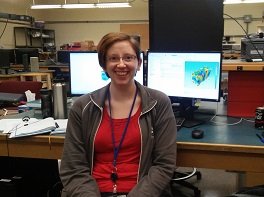Blog post by student researcher:
Heidi Fedorak, School of Energy
 Ever wonder why a place like San Francisco can go through a major earthquake with less severe destruction than a similar seismic event happening in other parts of the world? This summer, I had a chance to help BCIT on a theory that may play a tremendous role in saving lives during earthquakes by bashing concrete blocks together.
Ever wonder why a place like San Francisco can go through a major earthquake with less severe destruction than a similar seismic event happening in other parts of the world? This summer, I had a chance to help BCIT on a theory that may play a tremendous role in saving lives during earthquakes by bashing concrete blocks together.
Currently the most accurate and reliable method of testing the strength of a batch of concrete blocks is to select a sample block from the batch, place it in a hydraulic machine, and measure the compression strength required to crush the block. The equipment and skilled staff needed to perform these tests are expensive and not readily available in 3rd world countries, so buildings in these countries are often built with untested (and therefore; weaker) concrete. We see the results when earthquakes strike first world nations which get to build with stronger and more consistent concrete, as compared to when similar magnitude strikes hit countries which have to operate without reliable materials.
The research group I joined this summer at BCIT is working on a potentially life-saving technology: a method to test strength of concrete blocks that uses cheaper equipment, which is easy to implement, and does not destroy the block (again, reducing costs). This affordability and simplicity would make the technology available and usable in third world countries, and given the ability to build with stronger concrete, thousands of lives could be saved.
Inspired by the brick masons’ technique of tapping two bricks together and deciding if they are strong enough based on the resulting sound they generate, the Non-Destructive Acoustic Resonance Testing of Concrete (NDART) group is investigating the relationship between the strength of a concrete block and the speed of the acoustic waves that travel through the block when it is struck by another object. In previous years, the group built concrete blocks and test cylinders, measured their acoustic velocities and then crushed them to find their strength. Amazingly, a 95% correlation was found between strength of the cylinders and the speed of the sound travelling through them, and at minimum, a 93% correlation was observed between block strength and acoustic velocity!
This summer I came on board with the project to develop a software model of the acoustic frequencies of the cylinders and blocks. Since they have a simple shape, the theoretical model of acoustic frequencies in cylinders is well understood. Comparing the frequencies modelled by the software to the frequencies we measured for the cylinders will allow us to develop an accurate software model. The model will be extremely useful for predicting what frequencies (and thus strengths!) we can expect to see in the concrete blocks, which have much more complicated shapes than the cylinders. Eventually, the model has the potential to tell us what strengths we expect to measure from blocks stacked on a pallet, and possibly even blocks built into a wall, allowing us to estimate the strength of entire structures!
Before I came to BCIT, I completed a degree in astrophysics at UBC, where I worked as a research assistant to a radio astronomer and a particle physicist. The NDART project gave me the opportunity to add to that experience by working in a field of physics barely touched on in my undergraduate degree: continuum mechanics, the study of the mechanical behavior of solid materials. The physics that studies how sound waves move through concrete cylinders is directly related to strains and deformations of solid materials that determine whether a building or a bridge will collapse. This experience was invaluable to me as it opened up a whole new field of fascinating knowledge, and made me aware of opportunities in materials and building science that I may never discovered otherwise!
In addition, it has been a genuine pleasure working with my fellow summer student Miles Adamson and my supervisors Neil Cox and Jim Booth. Miles and I had a great time sharing a lab and collaborating on the science behind our work. Neil Cox provided excellent insight on how to “think like an engineer” and approach things outside the scope of my science training. Jim Booth’s patient instruction (along with constant optimism and encouragement) was incredibly helpful while I brushed up on my old physics skills. Between this team and the project, I got to immerse myself in an entirely new subject which made this summer a tremendously enjoyable experience. I would like to thank everyone involved for making this experience possible, and I look forward to the opportunities it will open up to me in the future!